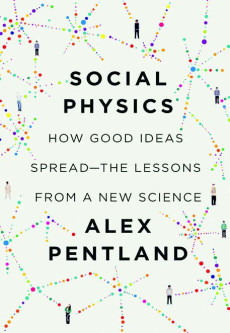
Social Physics: How Good Ideas Spread—The Lessons From a New Science
Alex Pentland
320 pages, Penguin Press, 2014
Auguste Comte, the founder of modern sociology, coined the phrase “social physics” back in the 19th century. Comte and others in that era aspired to explain social reality by developing a set of universal laws—the sociological equivalent of physicists’ quest to create a theory of everything. Since then, social scientists have become generally disillusioned with that notion. But their skepticism seems to have eluded Alex Pentland, director of the Human Dynamics Laboratory at the Massachusetts Institute of Technology and author of Social Physics. Along with fellow data scientists, computer engineers, and, yes, physicists, Pentland is a pioneering member of a movement that aims to harness information technology to create a data-driven mathematical model of social behavior.
Social Physics offers a summary of the groundbreaking work that Pentland, together with an army of graduate and postdoctoral students, has been conducting over the past decade. Pentland and his collaborators have used ingenious methods—including, most notably, the “sociometric badge,” a wearable device that records interpersonal communication—to discern patterns of human interaction in settings that range from dorm rooms to commercial banks to call centers. The central theme of this work is that the overall structure of a given network of interaction, rather than the content that people exchange through that network, determines the quality of “idea flow.” That is Pentland’s term for the way that behaviors and beliefs spread across a web of interpersonal relationships.
According to Pentland’s theory of idea flow, certain network structures are more conducive than others to the emergence of innovative ideas or to the coordination of collective action. In one study, for example, online day traders whose patterns of interaction give them access to different parts of an information network outperformed isolated mavericks or groups of traders who operate within informational “echo chambers.” In another experiment, the practice of equitably taking turns in conversation proved to be a stronger predictor of small-group performance than the intellectual capacities of individual group members. Pentland and his coauthors on that study use the term “collective intelligence” to describe this dynamic.
By itself, the idea that the structure of a network matters is hardly new. Neither is the finding that the best structure for developing and diffusing novel ideas is one that is poised between rigidity and randomness. The contention that critically important action emerges on the “edge of chaos” is a prevalent theme in the science of complex systems—a field that, in many ways, laid the theoretical foundations for the kind of computational social science that Pentland’s work exemplifies. What’s new about the research surveyed in Social Physics is the sheer volume and diversity of the data that it draws on, as well as the mathematical elegance and computational horsepower that Pentland and his colleagues bring to bear on this body of “big data.”
Social Physics is very much a work of practical science. In the second part of the book, Pentland moves from modeling social reality to suggesting tools for improving it. He describes a network visualization tool that can help managers identify how the informal structures of interaction in their organizations might impede social learning. He also demonstrates how the data collection tools made possible by digital technology can enable the design of effective incentive systems. Used correctly, in other words, social physics can be an instrument for creating organizations that are more efficient, more adaptive, and more productive. In the third and fourth parts of the book, Pentland extends that idea to argue that social physics can help us build “data-driven cities” and “data-driven societies.” This “new science,” he contends, will allow us to chart a future that avoids both the competitive frenzy of a market-based society and the fatalism of a class-based society.
At this point, the very meaning of “social physics” becomes a source of confusion: Is it a science, or is it an ideology? The toolkit of a social physicist comes with the potential for social engineering, and that prospect likely make some people uncomfortable. After all, the utopian vision of mastering the secrets of human interaction can easily transform into an Orwellian dystopia. When we apply the model of physics to social reality, perhaps we need to understand it not as a scientific framework, but as a metaphor. And that metaphor, illuminating though it is, eventually breaks down. Unlike the elementary particles that make up the natural world, the units of analysis in Pentland’s social physics—namely, people—are complex, varied, and unpredictable. Their social interaction invariably reflects the content that they exchange with one another; the structure of that interaction tells only part of the story.
Which isn’t to deny that Social Physics is a work of great value. Among the many recent books about the new science of networks, this one stands out for the breadth and ingenuity of its data-driven science, and for its commitment to translating scientific exploration into practical knowledge. Organizational scholars and organizational leaders alike will find it fascinating and useful. Those who seek to leverage the power of big data will no doubt find it inspiring as well.

